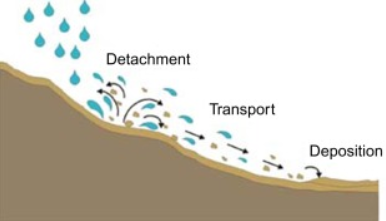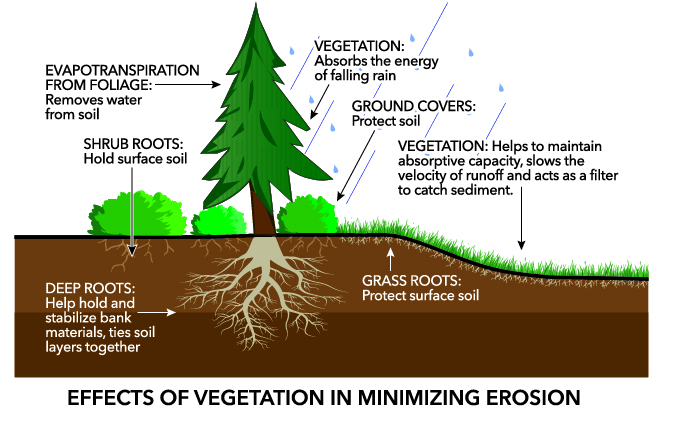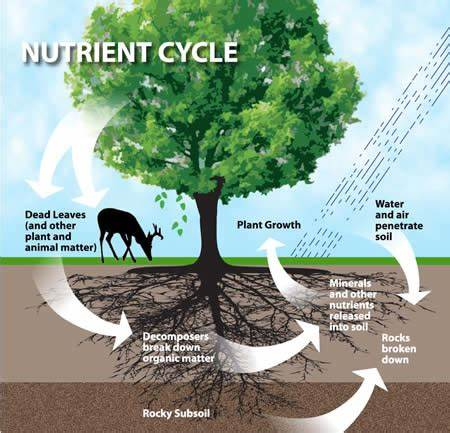Soil erosion is present all over the world. You probably notice it in coastal areas along jagged riverbanks, or maybe you notice it along interstates and highways. It is a natural process, but the result of consistent erosion can result in severe environmental changes.
Soil erosion washes away $8 billion each year. By wiping out the topsoil with runoff, floods, and heavy rains on slopes, agriculture begins to suffer immensely. The world is looking at lower food production by nearly 33.7 million tons of less food per year.
The good news is that soil erosion can be slowed, controlled, and prevented with the right education and materials, such as planting vegetation like trees.
What is Soil Erosion?
Think about soil for a second. What do you picture? It’s most likely dark, loose dirt that moves smoothly and crumbles in your hand. The part you’re able to grab from the ground is called topsoil. The scientific definition of soil erosion is the wearing away and displacement of topsoil.
Topsoil is the delicate top layer, also serving as the most fertile component to the entire ground’s ecosystem. Because of its delicacy, topsoil is easily blown away by wind or washed away by the rain.
Soil erosion is the direct cause of dying land, increased pollution, worsened flooding and mudslides, and deforestation — all of which can lead to clogged sewers, failing infrastructures, and less food for everybody.
How Trees Prevent Erosion
The process of soil erosion has three main parts:
- Detachment, where the topsoil is detached from the body of the soil.
- Transport, where the topsoil is relocated to another spot, by either wind or water forces.
- Deposition, where the earth finally ends up.
Natural forces often cause soil erosion, but the soil is often susceptible due to combined factors, such as:
- Water and wind
- Slope gradient
- Lack of vegetation
- Human activities
The good news is that there are several ways to help slow and prevent erosion. One of the most rewarding ways is by introducing trees to unprotected areas since trees protect soil, prevent surface runoff, and reintroduce nutrients by holding soil in place.
#1: Trees Protect Soil From Heavy Rain and Wind
Did you know one of the leading causes of soil erosion is caused by wind and water?
Water can displace soil in several forms, like rainfall, waves, ice, flooding, or excess runoff down slopes. Raindrops on the land surface often cause detachment of soil particles, causing the loose topsoil to flow away with the water. Wind easily displaces soil in areas where there’s not enough vegetation to protect the top layer, like in arid regions and coastal regions.
When trees are introduced as a method to stop erosion, they might be nicknamed “windbreaks.” Windbreaks are natural wind barriers, which refer to the tree’s branches and leaves. Serving as windbreaks, wind goes directly over the tall trees, which not only slows down the wind’s speed but also protects the soil directly beneath.
Thanks to their deep root systems and thick branches, they are an excellent solution for protecting soil from any weather condition.
#2: Trees Prevent Surface Runoff
Among the causes of soil erosion, surface runoff on slopes caused by water is a major reason. The general rule of thumb is the deeper the slope, the more likely erosion will occur. There are other components to soil erosion per the slope’s length, such as:
- Soil’s grain size
- Bulk density
- Surface roughness
- Runoff length
- Net rain excess
- The friction coefficient of soil
When a slope is going downhill, it naturally allows loose particles to fall. And with the slightest gust of wind or amount of rainfall, it’s common to see the displacement of soil. But by introducing more vegetation, plants and trees can help slow the process by acting as a barrier on deep slopes.
The key to stopping erosion with trees is to choose species that have two characteristics:
- Deep root systems, which means they do well on slopes and can help slow landslides and runoff
- Tall and robust with plenty of branches to serve as windbreaks
With their deep roots, trees can stop erosion caused by landslides. They’re especially useful on slopes, where their dense root systems help secure and protect the soil so that it’s less likely to become detached.
#3: Trees Reverse Nutrient Depletion
Nutrient depletion is a result of the loss of plant nutrients in the soil that is caused by high nutrient outputs, which results in a negative nutrient balance. Some higher nutrient output causes might include activities like leaching, crop harvesting, and erosion.
Unfortunately, leaching and crop harvesting are activities done by people. In fact, human activity causes ten times more erosion than all natural processes combined. Often, overcropping, overwatering, and overgrazing on farms can cause soil depletion, which in turn, leads to weak soil that is susceptible to soil erosion.
Planting trees in areas where nutrients are scarce is one of the best ways to bring back healthy and lively soil.
The tree’s deep roots help breakdown organic matter, which directly releases nutrients back into the soil, causing plant growth. More plant growth helps protect the topsoil from wind and water, which means that the soil is less likely to detach and transport.
Conclusion
Soil erosion is a natural phenomenon. However, with deforestation, deep slopes, lack of vegetation, and increasing human activities, the world is seeing erosion accelerate at higher speeds each year. And with more than 70 percent of the world’s land eroded, farmers are unable to supply as much food for the ever-growing population.
But everybody can do their part when it comes to erosion control. One simple and effective technique you can use is introducing crop covers and plant trees on your land. They help the local environment by protecting delicate soil from wind and rainfall, which in turn prevents landslides and surface runoff.
If you want to do your part in preventing soil erosion, you can find excellent erosion control and prevention techniques at Granite Seed.



